Abstract
Lead poisoning is the most common disease of environmental origin in the United States today. Adult lead poisoning results primarily from exposure by inhalation in the workplace. Pediatric lead poisoning results principally from the ingestion of lead from environmental media, including paint chips, dust, soil, drinking water, ceramics, and medications. Lead is toxic to many organ systems, among them developing erythrocytes, the kidneys, and the nervous system. Lead-induced toxicity to the central nervous system causes delayed development, diminished intelligence, and altered behavior. In young children, this effect has been demonstrated convincingly to occur at blood lead levels between 10 and 20 micrograms per dl. The Centers for Disease Control and Prevention has recommended that a blood lead level of 10 micrograms per dl or higher be considered evidence of increased lead absorption, and the National Academy of Sciences has concurred in that recommendation. Unresolved issues in need of further study include the frequency of screening young children for lead, the question of whether women should be offered screening for lead before conceiving a pregnancy, the role of x-ray fluorescence analysis in assessing lead in bone, and the appropriate legislative response of the United States government to lead-based paint abatement.
Full text
PDF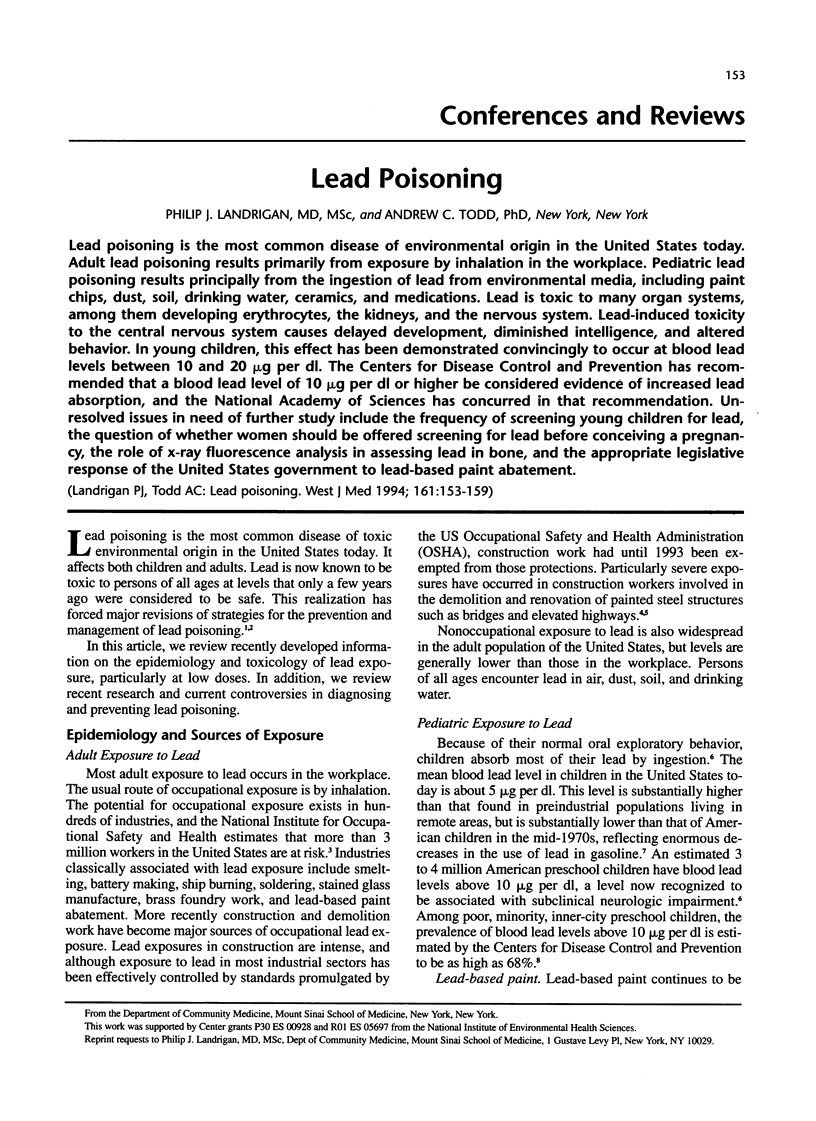
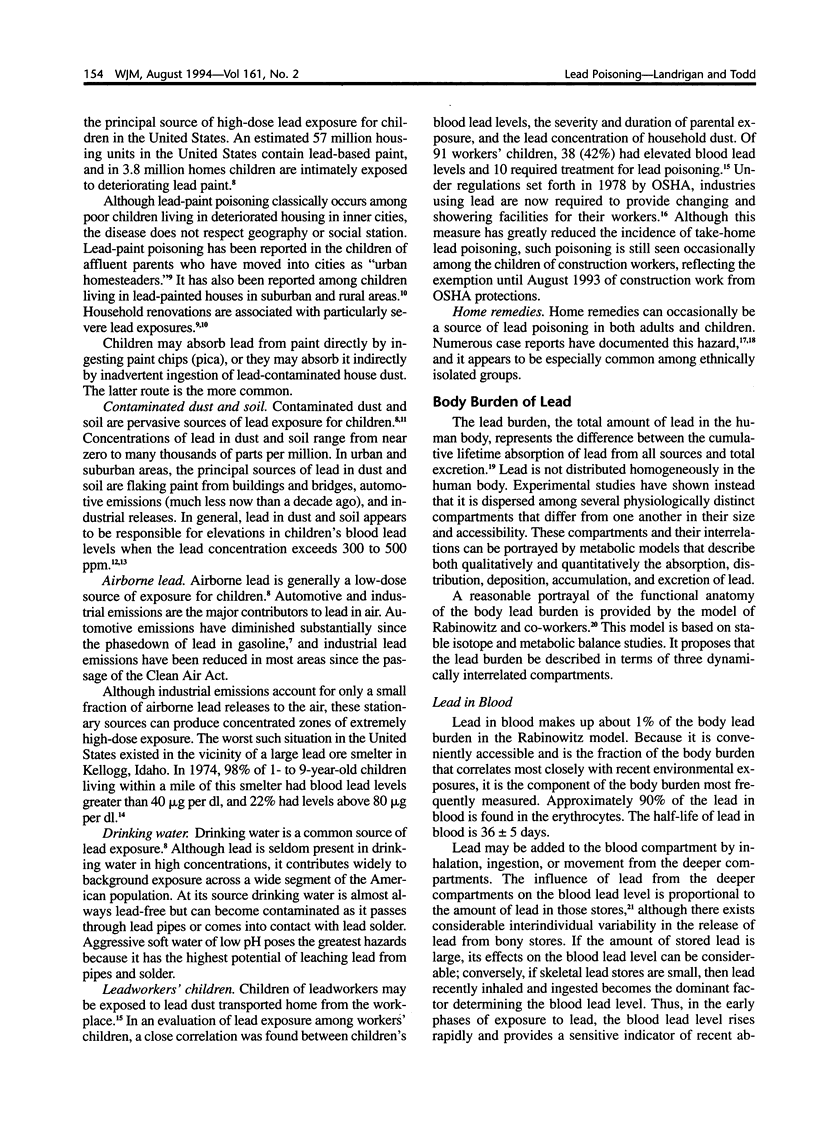
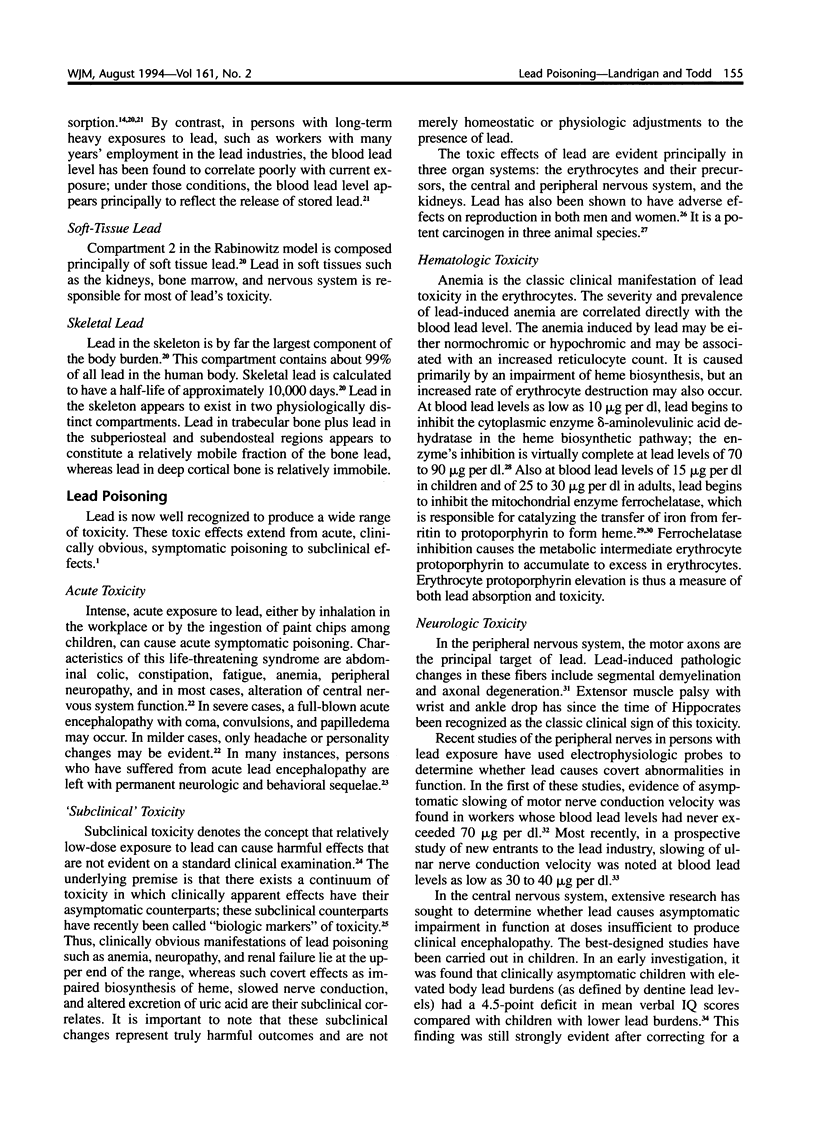
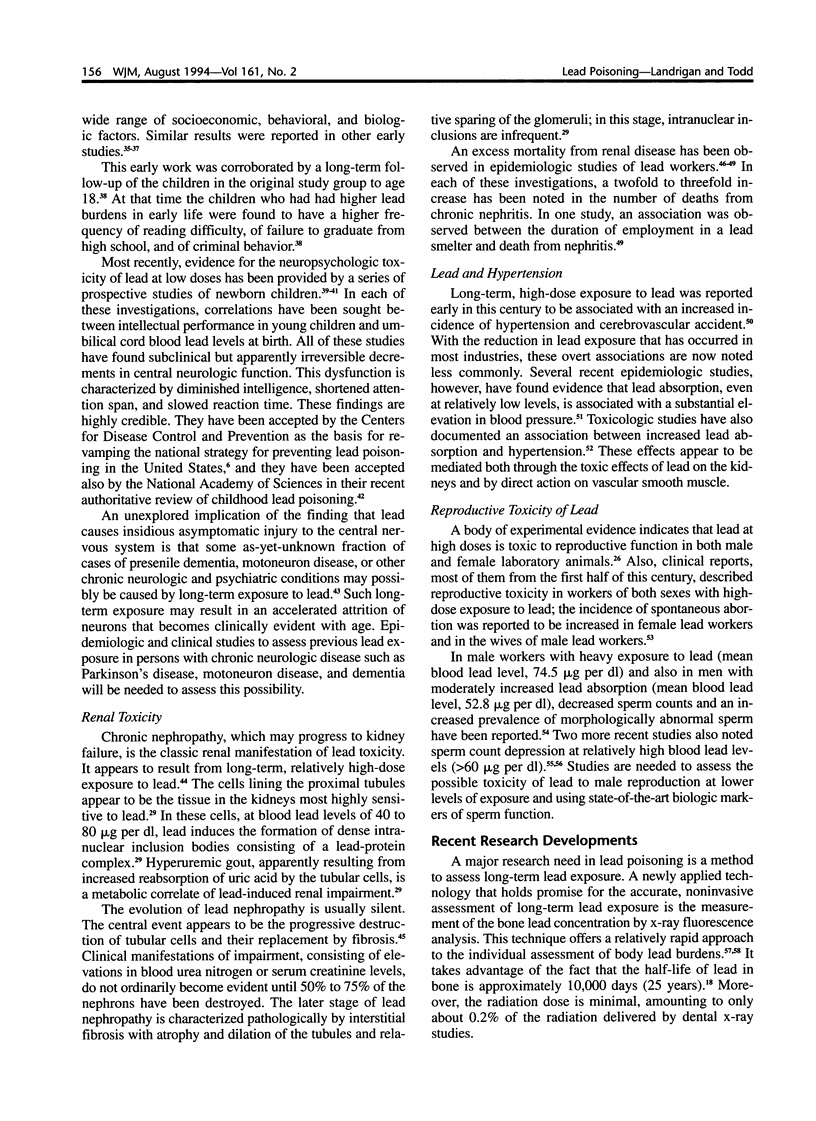
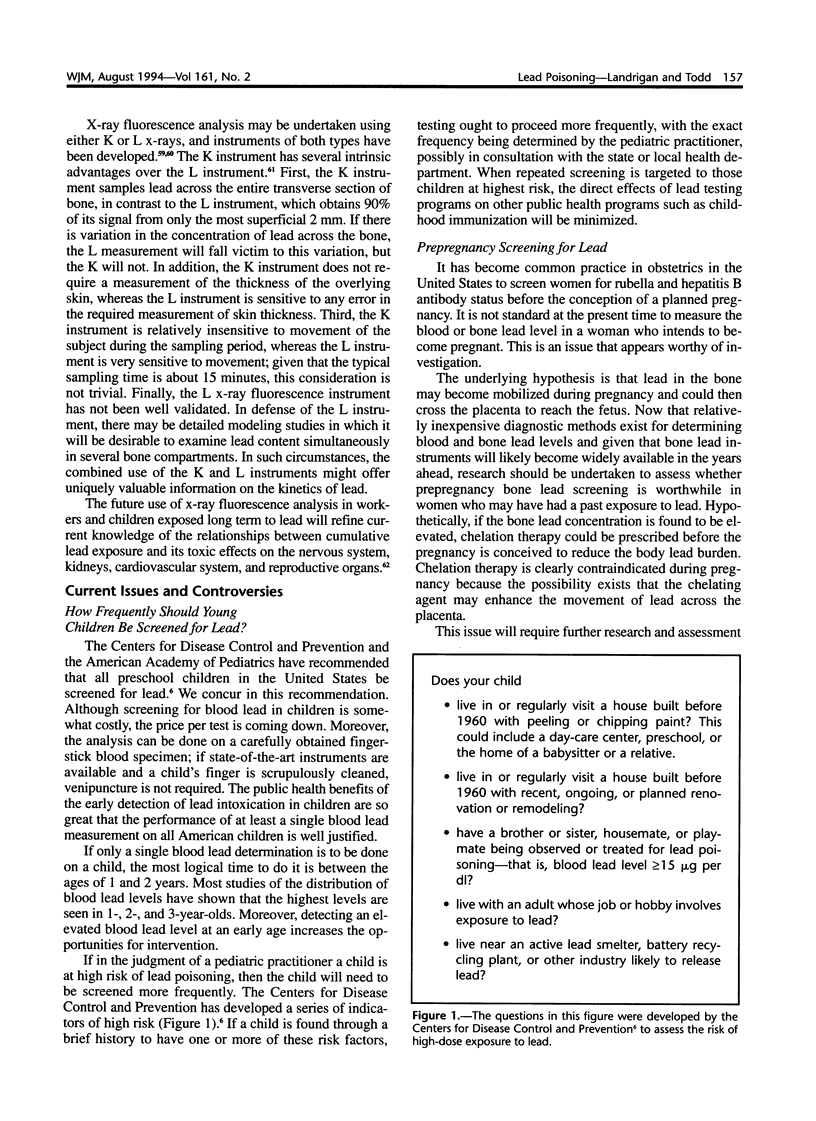
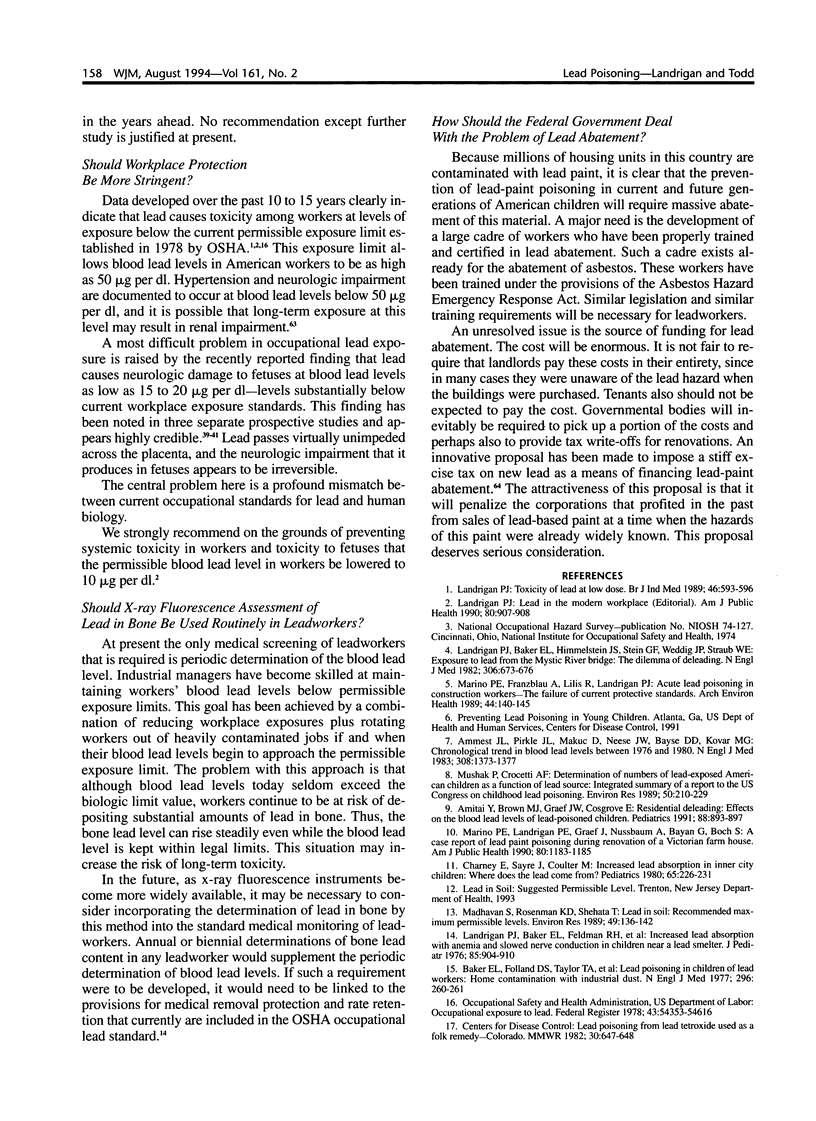

Selected References
These references are in PubMed. This may not be the complete list of references from this article.
- Ahlgren L., Mattsson S. An X-ray fluorescence technique for in vivo determination of lead concentration in a bone matrix. Phys Med Biol. 1979 Jan;24(1):136–145. doi: 10.1088/0031-9155/24/1/011. [DOI] [PubMed] [Google Scholar]
- Amitai Y., Brown M. J., Graef J. W., Cosgrove E. Residential deleading: effects on the blood lead levels of lead-poisoned children. Pediatrics. 1991 Nov;88(5):893–897. [PubMed] [Google Scholar]
- Annest J. L., Pirkle J. L., Makuc D., Neese J. W., Bayse D. D., Kovar M. G. Chronological trend in blood lead levels between 1976 and 1980. N Engl J Med. 1983 Jun 9;308(23):1373–1377. doi: 10.1056/NEJM198306093082301. [DOI] [PubMed] [Google Scholar]
- Assennato G., Paci C., Baser M. E., Molinini R., Candela R. G., Altamura B. M., Giorgino R. Sperm count suppression without endocrine dysfunction in lead-exposed men. Arch Environ Health. 1986 Nov-Dec;41(6):387–390. doi: 10.1080/00039896.1986.9935784. [DOI] [PubMed] [Google Scholar]
- Baker E. L., Folland D. S., Taylor T. A., Frank M., Peterson W., Lovejoy G., Cox D., Housworth J., Landrigan P. J. Lead poisoning in children of lead workers: home contamination with industrial dust. N Engl J Med. 1977 Feb 3;296(5):260–261. doi: 10.1056/NEJM197702032960507. [DOI] [PubMed] [Google Scholar]
- Bellinger D., Leviton A., Waternaux C., Needleman H., Rabinowitz M. Longitudinal analyses of prenatal and postnatal lead exposure and early cognitive development. N Engl J Med. 1987 Apr 23;316(17):1037–1043. doi: 10.1056/NEJM198704233161701. [DOI] [PubMed] [Google Scholar]
- Biological markers in environmental health research. Committee on Biological Markers of the National Research Council. Environ Health Perspect. 1987 Oct;74:3–9. doi: 10.1289/ehp.74-1474499. [DOI] [PMC free article] [PubMed] [Google Scholar]
- Charney E., Sayre J., Coulter M. Increased lead absorption in inner city children: where does the lead come from? Pediatrics. 1980 Feb;65(2):226–231. [PubMed] [Google Scholar]
- Cooper W. C., Gaffey W. R. Mortality of lead workers. J Occup Med. 1975 Feb;17(2):100–107. doi: 10.1097/00043764-197502000-00012. [DOI] [PubMed] [Google Scholar]
- Cullen M. R., Kayne R. D., Robins J. M. Endocrine and reproductive dysfunction in men associated with occupational inorganic lead intoxication. Arch Environ Health. 1984 Nov-Dec;39(6):431–440. doi: 10.1080/00039896.1984.10545877. [DOI] [PubMed] [Google Scholar]
- Cullen M. R., Robins J. M., Eskenazi B. Adult inorganic lead intoxication: presentation of 31 new cases and a review of recent advances in the literature. Medicine (Baltimore) 1983 Jul;62(4):221–247. [PubMed] [Google Scholar]
- DINGWALL-FORDYCE I., LANE R. E. A FOLLOW-UP STUDY OF LEAD WORKERS. Br J Ind Med. 1963 Oct;20:313–315. doi: 10.1136/oem.20.4.313. [DOI] [PMC free article] [PubMed] [Google Scholar]
- Dietrich K. N., Succop P. A., Berger O. G., Hammond P. B., Bornschein R. L. Lead exposure and the cognitive development of urban preschool children: the Cincinnati Lead Study cohort at age 4 years. Neurotoxicol Teratol. 1991 Mar-Apr;13(2):203–211. doi: 10.1016/0892-0362(91)90012-l. [DOI] [PubMed] [Google Scholar]
- Fullerton P. M. Chronic peripheral neuropathy produced by lead poisoning in guinea-pigs. J Neuropathol Exp Neurol. 1966 Apr;25(2):214–236. doi: 10.1097/00005072-196604000-00003. [DOI] [PubMed] [Google Scholar]
- Goyer R. A., Rhyne B. C. Pathological effects of lead. Int Rev Exp Pathol. 1973;12:1–77. [PubMed] [Google Scholar]
- Hernberg S., Nikkanen J., Mellin G., Lilius H. Delta-aminolevulinic acid dehydrase as a measure of lead exposure. Arch Environ Health. 1970 Aug;21(2):140–145. doi: 10.1080/00039896.1970.10667211. [DOI] [PubMed] [Google Scholar]
- Kazantzis G. Role of cobalt, iron, lead, manganese, mercury, platinum, selenium, and titanium in carcinogenesis. Environ Health Perspect. 1981 Aug;40:143–161. doi: 10.1289/ehp.8140143. [DOI] [PMC free article] [PubMed] [Google Scholar]
- Lancranjan I., Popescu H. I., GAvănescu O., Klepsch I., Serbănescu M. Reproductive ability of workmen occupationally exposed to lead. Arch Environ Health. 1975 Aug;30(8):396–401. doi: 10.1080/00039896.1975.10666733. [DOI] [PubMed] [Google Scholar]
- Landrigan P. J., Baker E. L., Jr, Feldman R. G., Cox D. H., Eden K. V., Orenstein W. A., Mather J. A., Yankel A. J., Von Lindern I. H. Increased lead absorption with anemia and slowed nerve conduction in children near a lead smelter. J Pediatr. 1976 Dec;89(6):904–910. doi: 10.1016/s0022-3476(76)80594-x. [DOI] [PubMed] [Google Scholar]
- Landrigan P. J., Baker E. L., Jr, Himmelstein J. S., Stein G. F., Weddig J. P., Straub W. E. Exposure to lead from the Mystic River Bridge: the dilemma of deleading. N Engl J Med. 1982 Mar 18;306(11):673–676. doi: 10.1056/NEJM198203183061112. [DOI] [PubMed] [Google Scholar]
- Landrigan P. J., Goyer R. A., Clarkson T. W., Sandler D. P., Smith J. H., Thun M. J., Wedeen R. P. The work-relatedness of renal disease. Arch Environ Health. 1984 May-Jun;39(3):225–230. doi: 10.1080/00039896.1984.9939529. [DOI] [PubMed] [Google Scholar]
- Landrigan P. J., Silbergeld E. K., Froines J. R., Pfeffer R. M. Lead in the modern workplace. Am J Public Health. 1990 Aug;80(8):907–908. doi: 10.2105/ajph.80.8.907. [DOI] [PMC free article] [PubMed] [Google Scholar]
- Landrigan P. J. Strategies for epidemiologic studies of lead in bone in occupationally exposed populations. Environ Health Perspect. 1991 Feb;91:81–86. doi: 10.1289/ehp.919181. [DOI] [PMC free article] [PubMed] [Google Scholar]
- Landrigan P. J. Toxicity of lead at low dose. Br J Ind Med. 1989 Sep;46(9):593–596. doi: 10.1136/oem.46.9.593. [DOI] [PMC free article] [PubMed] [Google Scholar]
- Landrigan P. J., Whitworth R. H., Baloh R. W., Staehling N. W., Barthel W. F., Rosenblum B. F. Neuropsychological dysfunction in children with chronic low-level lead absorption. Lancet. 1975 Mar 29;1(7909):708–712. doi: 10.1016/s0140-6736(75)91627-x. [DOI] [PubMed] [Google Scholar]
- Madhavan S., Rosenman K. D., Shehata T. Lead in soil: recommended maximum permissible levels. Environ Res. 1989 Jun;49(1):136–142. doi: 10.1016/s0013-9351(89)80028-3. [DOI] [PubMed] [Google Scholar]
- Malcolm D., Barnett H. A. A mortality study of lead workers 1925-76. Br J Ind Med. 1982 Nov;39(4):404–410. doi: 10.1136/oem.39.4.404. [DOI] [PMC free article] [PubMed] [Google Scholar]
- Marino P. E., Franzblau A., Lilis R., Landrigan P. J. Acute lead poisoning in construction workers: the failure of current protective standards. Arch Environ Health. 1989 May-Jun;44(3):140–145. doi: 10.1080/00039896.1989.9935877. [DOI] [PubMed] [Google Scholar]
- Marino P. E., Landrigan P. J., Graef J., Nussbaum A., Bayan G., Boch K., Boch S. A case report of lead paint poisoning during renovation of a Victorian farmhouse. Am J Public Health. 1990 Oct;80(10):1183–1185. doi: 10.2105/ajph.80.10.1183. [DOI] [PMC free article] [PubMed] [Google Scholar]
- McMichael A. J., Baghurst P. A., Wigg N. R., Vimpani G. V., Robertson E. F., Roberts R. J. Port Pirie Cohort Study: environmental exposure to lead and children's abilities at the age of four years. N Engl J Med. 1988 Aug 25;319(8):468–475. doi: 10.1056/NEJM198808253190803. [DOI] [PubMed] [Google Scholar]
- McMichael A. J., Johnson H. M. Long-term mortality profile of heavily-exposed lead smelter workers. J Occup Med. 1982 May;24(5):375–378. doi: 10.1097/00043764-198205000-00008. [DOI] [PubMed] [Google Scholar]
- Mushak P., Crocetti A. F. Determination of numbers of lead-exposed American children as a function of lead source: integrated summary of a report to the U.S. Congress on childhood lead poisoning. Environ Res. 1989 Dec;50(2):210–229. doi: 10.1016/s0013-9351(89)80002-7. [DOI] [PubMed] [Google Scholar]
- Needleman H. L., Gunnoe C., Leviton A., Reed R., Peresie H., Maher C., Barrett P. Deficits in psychologic and classroom performance of children with elevated dentine lead levels. N Engl J Med. 1979 Mar 29;300(13):689–695. doi: 10.1056/NEJM197903293001301. [DOI] [PubMed] [Google Scholar]
- Needleman H. L., Schell A., Bellinger D., Leviton A., Allred E. N. The long-term effects of exposure to low doses of lead in childhood. An 11-year follow-up report. N Engl J Med. 1990 Jan 11;322(2):83–88. doi: 10.1056/NEJM199001113220203. [DOI] [PubMed] [Google Scholar]
- Pirkle J. L., Schwartz J., Landis J. R., Harlan W. R. The relationship between blood lead levels and blood pressure and its cardiovascular risk implications. Am J Epidemiol. 1985 Feb;121(2):246–258. doi: 10.1093/oxfordjournals.aje.a113995. [DOI] [PubMed] [Google Scholar]
- Rabinowitz M. B., Wetherill G. W., Kopple J. D. Kinetic analysis of lead metabolism in healthy humans. J Clin Invest. 1976 Aug;58(2):260–270. doi: 10.1172/JCI108467. [DOI] [PMC free article] [PubMed] [Google Scholar]
- Roels H., Bruaux P., Buchet J. P., Claeys-Thoreau F., Lauwerys R., Lafontaine A., Hubermont G., Van Overschelde J. Impact of air pollution by lead on the heme biosynthetic pathway in school-age children. Arch Environ Health. 1976 Nov-Dec;31(6):310–316. doi: 10.1080/00039896.1976.10667241. [DOI] [PubMed] [Google Scholar]
- Selevan S. G., Landrigan P. J., Stern F. B., Jones J. H. Mortality of lead smelter workers. Am J Epidemiol. 1985 Oct;122(4):673–683. doi: 10.1093/oxfordjournals.aje.a114146. [DOI] [PubMed] [Google Scholar]
- Seppäläinen A. M., Hernberg S., Vesanto R., Kock B. Early neurotoxic effects of occupational lead exposure: a prospective study. Neurotoxicology. 1983 Summer;4(2):181–192. [PubMed] [Google Scholar]
- Seppäläinen A. M., Tola S., Hernberg S., Kock B. Subclinical neuropathy at "safe" levels of lead exposure. Arch Environ Health. 1975 Apr;30(4):180–183. doi: 10.1080/00039896.1975.10666672. [DOI] [PubMed] [Google Scholar]
- Somervaille L. J., Chettle D. R., Scott M. C. In vivo measurement of lead in bone using x-ray fluorescence. Phys Med Biol. 1985 Sep;30(9):929–943. doi: 10.1088/0031-9155/30/9/005. [DOI] [PubMed] [Google Scholar]
- Somervaille L. J., Chettle D. R., Scott M. C., Tennant D. R., McKiernan M. J., Skilbeck A., Trethowan W. N. In vivo tibia lead measurements as an index of cumulative exposure in occupationally exposed subjects. Br J Ind Med. 1988 Mar;45(3):174–181. doi: 10.1136/oem.45.3.174. [DOI] [PMC free article] [PubMed] [Google Scholar]
- Todd A. C., McNeill F. E., Fowler B. A. In vivo X-ray fluorescence of lead in bone. Environ Res. 1992 Dec;59(2):326–335. doi: 10.1016/s0013-9351(05)80039-8. [DOI] [PubMed] [Google Scholar]
- Victery W., Vander A. J., Shulak J. M., Schoeps P., Julius S. Lead, hypertension, and the renin-angiotensin system in rats. J Lab Clin Med. 1982 Mar;99(3):354–362. [PubMed] [Google Scholar]
- Wielopolski L., Rosen J. F., Slatkin D. N., Vartsky D., Ellis K. J., Cohn S. H. Feasibility of noninvasive analysis of lead in the human tibia by soft x-ray fluorescence. Med Phys. 1983 Mar-Apr;10(2):248–251. doi: 10.1118/1.595244. [DOI] [PubMed] [Google Scholar]
- Yule Q., Lansdown R., Millar I. B., Urbanowicz M. A. The relationship between blood lead concentrations, intelligence and attainment in a school population: a pilot study. Dev Med Child Neurol. 1981 Oct;23(5):567–576. doi: 10.1111/j.1469-8749.1981.tb02038.x. [DOI] [PubMed] [Google Scholar]


